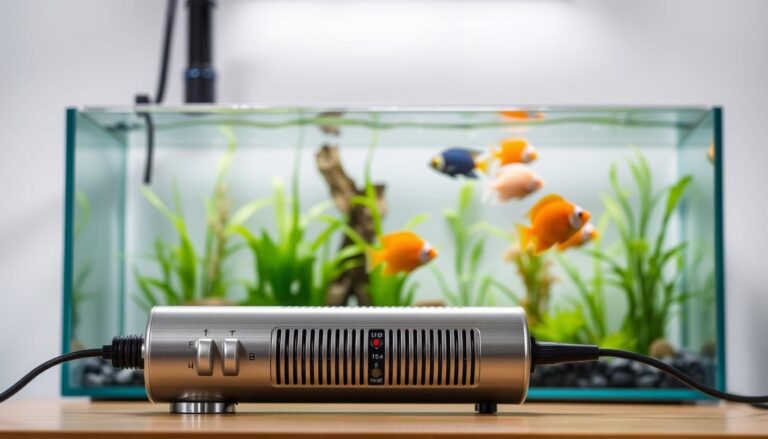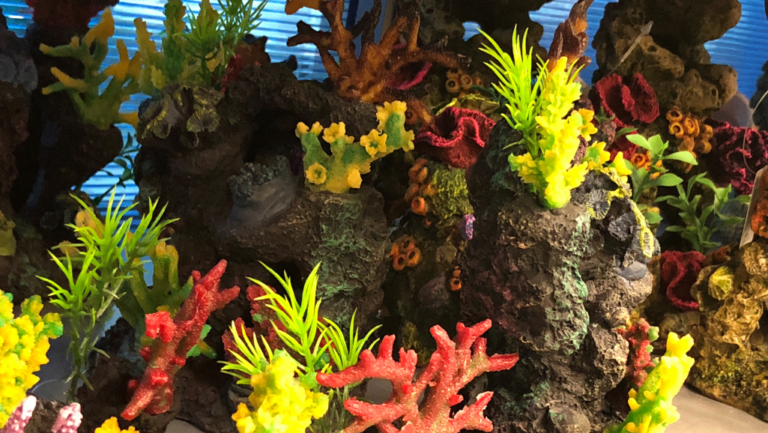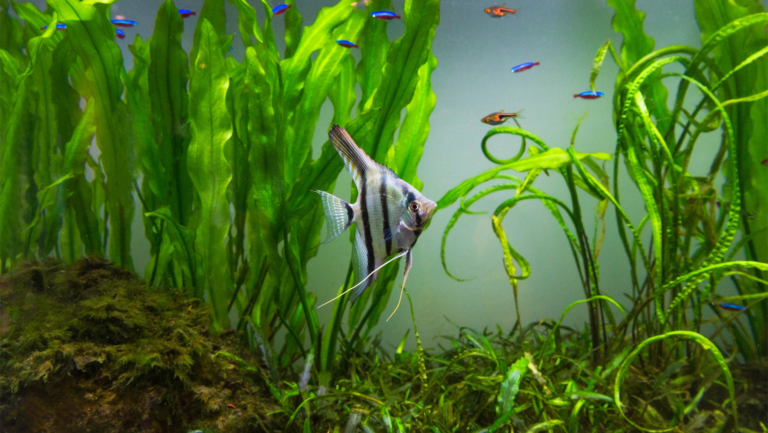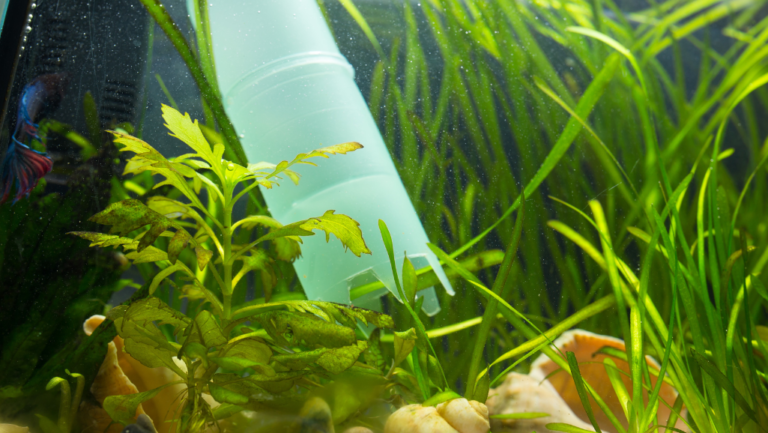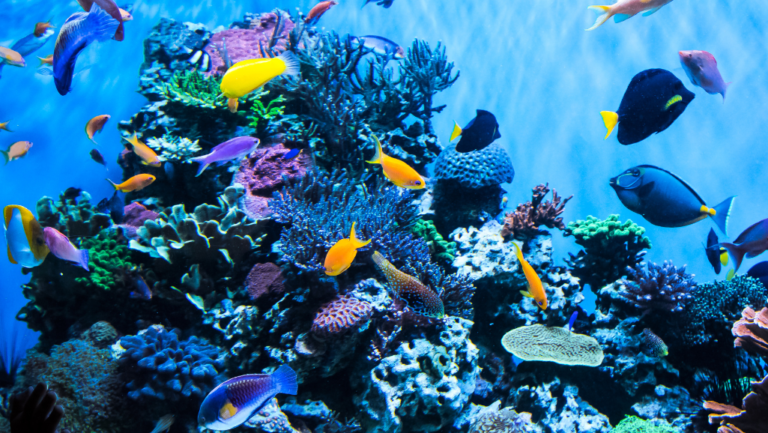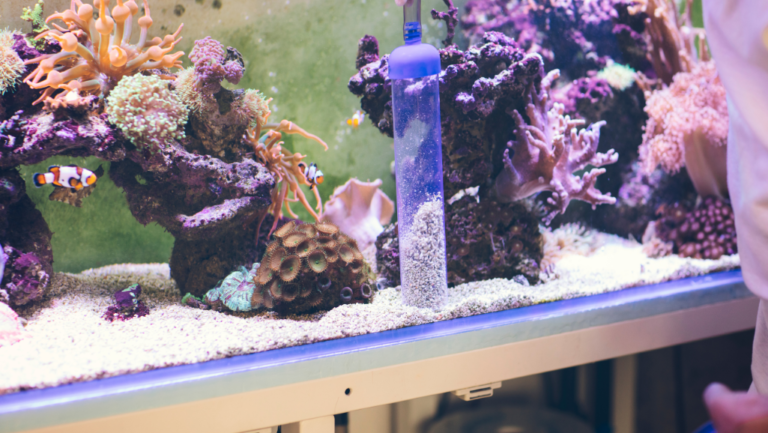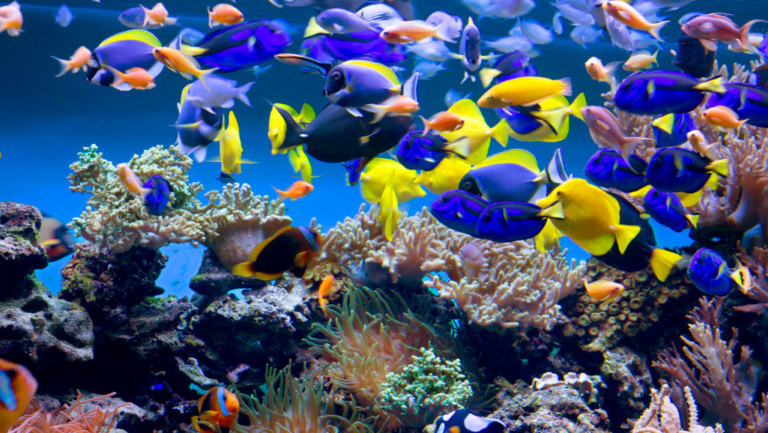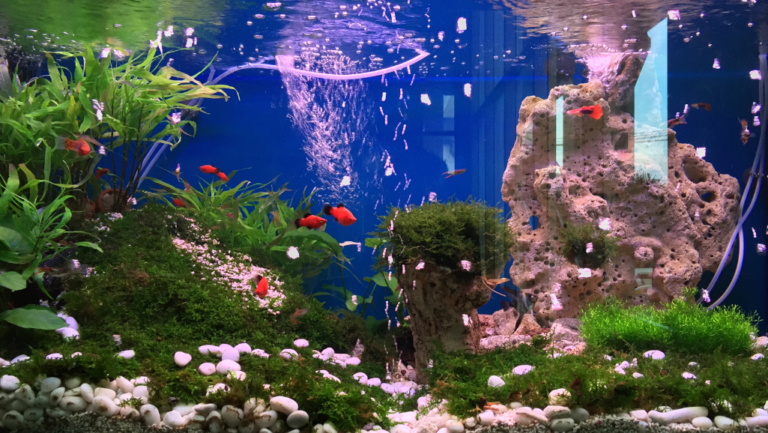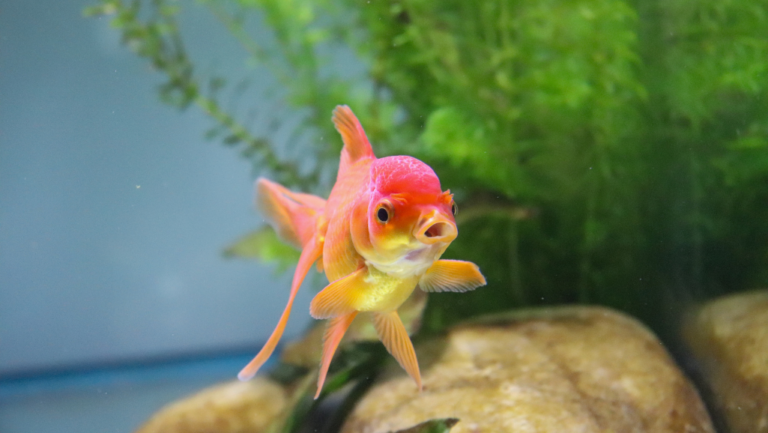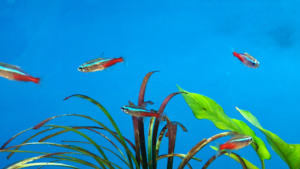Achieving crystal clear water in your marine aquarium is every aquarist’s dream. It makes your underwater world look stunning and keeps your marine life healthy. Proper filtration is essential for a thriving aquatic ecosystem. Knowing how it works is vital for your success.
Dirty aquariums are a common reason people give up on fishkeeping. By mastering marine aquarium filtration, you’ll keep your tank water clean. This guide will explore filtration’s importance, types, and best practices. We’ll help you achieve that crystal clear water you’ve always wanted.
Key Takeaways
- Maintaining crystal clear water is vital for your marine life’s health and your enjoyment.
- Filtration is the key to a clean and thriving aquatic ecosystem.
- Mechanical, biological, and chemical filtration work together to keep your water pristine.
- Choosing the right filtration system depends on tank size and bioload.
- Regular maintenance and best practices ensure optimal filter performance and a healthy aquarium environment.
Understanding Marine Aquarium Filtration
To have a thriving marine aquarium, you need to know about filtration. It’s key to keeping the water clean for your fish and other sea creatures. Filtration removes bad stuff and waste from the water, making a safe space for them.
Filtration in marine aquariums has three main parts: mechanical, biological, and chemical. Each part is important for keeping the water clear and safe from harmful stuff.
What is Filtration?
Mechanical filtration catches and removes solid waste like fish poop and leftover food. It uses things like filter socks and roller filters. You need to clean these filters often to keep them working well.
Biological filtration uses good bacteria to break down bad stuff like ammonia. These bacteria live on surfaces like live rock and special media. They help turn ammonia into safer substances.
Chemical filtration uses media like activated carbon to get rid of dissolved bad stuff. Activated carbon is great at removing smells and some chemicals. Granular ferric oxide (GFO) is used to get rid of phosphate and some silicates.
Importance of Filtration in Marine Aquariums
Good water quality is essential for marine life. Filtration keeps the water stable by removing bad stuff and controlling nutrients. Without it, fish can get sick or even die.
Filtration also makes your aquarium look great. Clear water lets you see the colors and details of your fish and decorations.
Knowing about different filtration types is key to a successful marine aquarium. With the right system and regular care, you can have a beautiful and healthy underwater world.
Types of Filtration Systems
To keep your marine aquarium thriving, knowing about different filtration systems is key. Each type helps keep the water clean and healthy for your fish. Let’s explore the main types: mechanical, biological, and chemical.
Mechanical Filtration
Mechanical filtration catches particles like fish waste and uneaten food. It uses tools like filter socks or sponge filters to trap debris. The best media can catch particles as small as one micron, which is tiny.
Hang-on-back filters and canister filters are popular choices. They offer good filtration but need regular cleaning or replacement.
Biological Filtration
Biological filtration is vital for a healthy aquarium. It relies on beneficial bacteria to break down organic waste. Bio-media like ceramic rings help these bacteria grow and work well.
Having enough nitrifying bacteria is key for aquarium survival. Methods like refugiums can also help reduce nitrates and phosphates.
Live plants can also act as a filter, removing toxins better than bacteria. Fluidized bed filters, like the Ziss Bubble Moving Media Filter, are great for tanks with lots of fish.
Chemical Filtration
Chemical filtration removes contaminants through chemical reactions. Media like activated carbon is very effective. It removes harmful substances like copper and chlorine.
When setting up your system, remember the order: mechanical first, then chemical, and lastly biological. This order helps keep your aquarium water clean and healthy for your fish.
Choosing the Right Filtration System
Setting up a marine aquarium means picking the right filtration system. This choice affects your fish’s health and happiness. With many filter types out there, think about aquarium size, fish population, and marine life compatibility. This ensures clean water and a healthy home for your fish.
The size of your tank is key in choosing a filter. Hang-On-Back (HOB) filters work well for smaller tanks because they’re easy to set up and maintain. For bigger tanks, canister filters are better. They can handle more water and have advanced filtration.
Factors to Consider
When picking a filter, keep these points in mind:
- Aquarium size: Pick a filter that can handle 3-4 times your tank’s volume.
- Fish population: More fish need stronger filters to keep water clean.
- Budget: Advanced filters like canisters cost more, but are worth it. Sponge and undergravel filters are cheaper.
- Maintenance: Clean your filters regularly to keep them working well.
Compatibility with Marine Life
Each marine creature needs specific water conditions. Your filter must meet these needs. For example, reef tanks need protein skimmers and media reactors. Canister filters are good for fish-only tanks, while hang-on filters work well in saltwater quarantine tanks.
“Choosing the right filtration system is not just about maintaining crystal-clear water; it’s about creating a healthy and balanced environment for your marine life to thrive.”
Using different filters together can improve your tank’s filtration. Testing your water often is key. It helps keep ammonia, nitrite, and nitrate levels stable. This ensures a safe and caring space for your marine friends.
Setting Up Your Filtration System
Setting up a filtration system for your marine aquarium is key. You need to follow a step-by-step guide for your filter type. This ensures a healthy and thriving underwater world.
Step-by-Step Installation Guide
First, read the manufacturer’s instructions for your filter. Make sure you have all parts and tools before you start. Here are some steps to follow:
- Position the filter in your aquarium as the manufacturer suggests.
- Connect the hoses and pipes securely to avoid leaks.
- Put the filter media in the right spots, like mechanical, biological, and chemical media.
- Prime the filter if needed and start the filtration.
- Adjust the water flow for the best filtration and circulation.
Best Practices for Aquarists
To keep your filtration system working well and your aquarium healthy, follow these tips:
- Place filter media correctly for better filtration and water flow.
- Give beneficial bacteria time to grow in the biological media. This is key for breaking down waste.
- Keep your filtration system clean by replacing or cleaning media as needed.
- Check water quality often and adjust your system if needed.
Remember, a well-designed and well-maintained filtration system is the heart of a thriving marine aquarium. By following these steps and tips, you’ll create a clear and healthy home for your marine friends.
Maintenance of Filtration Systems
Keeping your marine aquarium’s filtration system in top shape is key for your fish’s health. Regular maintenance keeps your tank clear and free from toxins and debris.
Aquarium fans spend about 15 minutes daily on upkeep. This includes checking water levels and replacing lost water. It’s wise to test for ammonia, nitrite, nitrate, and phosphate weekly to spot issues early.
Routine Maintenance Tasks
To ensure your filtration system works well, follow these steps:
- Clean or replace filter media, like sponges and filter floss, every few days before or after water changes.
- Swap out activated carbon every two months to keep it effective at removing toxins.
- Do partial water changes of 10% of the tank’s volume every two weeks or at least monthly.
- Change bulbs and/or tubes in your lighting system every six months to a year to keep your marine life well-lit.
When cleaning filter media, use tank water. This avoids harming the beneficial bacteria that keep your tank healthy.
Troubleshooting Common Issues
Even with regular care, you might face some common problems. If water flow is low or filters are clogged, check and clean the parts or adjust the media. Replace damaged parts quickly to avoid more issues.
“The key to a thriving marine aquarium is diligence in filter maintenance and a proactive approach to troubleshooting filtration issues.” – Experienced Aquarist
By keeping up with maintenance and fixing problems fast, you’ll create a great home for your marine life. A well-kept filtration system is essential for a stunning marine aquarium.
The Role of Live Rock in Filtration
Live rock is key in marine aquariums. It keeps the water clear and the environment healthy. This coral skeleton is full of good bacteria and marine life, acting as a natural filter.
Benefits of Live Rock
Live rock has many benefits. It’s great for biological filtration. It hosts many bacteria that clean waste. Coral reef rock is perfect for these bacteria, with algae and biomass growing well in its crevices.
It also makes your aquarium look amazing. Live rock gives your fish places to hide and reduces stress. It also helps keep the water chemistry stable by adding minerals like calcium.
How to Use Live Rock Effectively
To get the most out of live rock, place it wisely. Create a beautiful layout that lets water flow well. This helps the beneficial bacteria grow. Think about your fish’s needs when arranging the rock, giving them plenty of places to hide.
“Live rock has been suggested by virtually every author in the aquarium hobby for the last 15 years as a means of biological filtration.”
Be patient when adding live rock to your tank. It takes time for the bacteria and marine life to settle in. This patience is important for a healthy aquarium.
Live rock is not just for biological filtration. It also makes your marine aquarium decor look natural and beautiful. By using live rock well, you can create a stunning underwater world that brings joy and peace.
The Importance of Water Quality
Keeping the water in your aquarium clean is key for your marine life’s health. Bad water quality can stress, make sick, or even kill your fish. It’s important to know what affects water quality and how to keep it right.
Parameters to Monitor
There are a few important things to watch in your aquarium’s water. These are:
- Ammonia: This is harmful to fish even at very small amounts. It comes from fish waste and uneaten food. It should be zero.
- Nitrite: This is also bad for fish and comes from bacteria breaking down ammonia. It should also be zero.
- Nitrate: This is less harmful but can be bad in high amounts. Keep it below 20ppm with regular water changes and good filters.
- pH: This measures how acidic or alkaline the water is. It should be between 8.0 and 8.4 for your fish.
- Salinity: This is the salt level in your water. It should be around 1.025 specific gravity for most marine tanks.
Testing Water Quality
Testing your water regularly is vital to keep it balanced. Get good test kits for ammonia, nitrite, nitrate, pH, and salinity. Test your water at least once a week, more often if you see any signs of stress in your fish.
“The key to success is to start before you are ready.”
This advice from Marie Forleo is true for aquarium water quality. Don’t wait for problems to start testing and maintaining your water. By testing and keeping your water balanced regularly, you’ll have a healthy home for your fish.
Doing a 20% water change can cut nitrates by 20%. Change about 10% of the water each week to keep nitrates low. Use top-quality salt mixes to keep your water chemistry stable.
Also, using good filters like live rock and protein skimmers helps. They promote good bacteria and remove bad stuff from the water.
Advanced Filtration Techniques
If you love marine aquariums, you might know about basic filters. But to really improve your tank’s water quality, you should look into more advanced methods. Two popular ones are refugiums and protein skimmers.
Refugiums for Nutrient Control
A refugium is a special area in your tank. It’s where good algae and creatures live. Its main job is to keep nutrients like nitrates and phosphates low. This stops algae from growing too much in your main tank.
By growing algae like Chaetomorpha or Caulerpa in the refugium, you make a natural filter. It takes in bad stuff from the water. These algae also feed your fish and inverts, helping them stay healthy.
Setting up a refugium is easy. You can use a spare tank or even a part of your main tank. With the right light and water flow, it becomes a lively part of your aquarium. This makes your tank more stable and healthy.
Protein Skimmers Explained
Protein skimmers remove bad stuff from your tank’s water. This bad stuff, like proteins and amino acids, can make your water quality suffer if not dealt with.
Skimmers work by making a foam that catches these bad compounds. Water mixed with air creates bubbles. The bad stuff sticks to these bubbles, forming foam that you can easily remove.
“Protein skimmers are an essential component of any well-maintained marine aquarium. They help to keep the water crystal clear and reduce the organic load on other filtration components.”
When picking a protein skimmer, think about your tank’s size and how much life it has. Also, make sure it fits with your current setup. Keeping the skimmer clean and adjusting it as needed is key for it to work well.
Adding refugiums and protein skimmers to your tank’s filter system can really boost your water quality. These advanced methods work together with basic filters to make a great home for your fish and inverts.
Innovations in Aquarium Filtration
The world of aquarium filtration is always changing. New technologies and solutions are coming out to help marine life thrive. It’s important for aquarists and experts to know about these advancements.
New Technologies in Filtration
Advanced filter media, like ceramic rings, are now used. They offer a lot of space for beneficial bacteria to grow. This helps break down waste and keeps the water healthy.
Smart filtration systems are also becoming popular. They let you check and control your equipment from anywhere. These systems have features like real-time monitoring and reminders, making it easier to keep your aquarium perfect.
“MAT Filtration Technologies has been at the forefront of aquarium filtration innovation, serving customers worldwide for over a decade. Our advanced systems have been implemented in renowned aquariums like the Poema del Mar in Gran Canaria, Spain, where we managed the filtration for their impressive 12,500 square meter facility housing over 550 species.”
Industry Trends to Watch
The aquarium industry is growing fast, and new trends are emerging. One big trend is focusing on being eco-friendly. Companies like MAT Filtration Technologies are making systems that use less water and energy.
There’s also a need for custom solutions for big aquariums. MAT Filtration Technologies has shown it can handle these projects. They design systems that meet the needs of different marine species, ensuring great water quality.
For those who love aquariums, keeping up with new filtration technology is key. By using the latest advancements, you can make your aquarium the best it can be. This way, you can give the best care to the amazing creatures in your tank.
Common Misconceptions About Filtration
Being a marine aquarium fan means knowing about filtration well. But, myths and misconceptions can harm your tank’s health. They can lead to poor water quality and sickness in your fish.
Some think bigger filters are always better. But, the right filter size depends on your tank’s needs. Too big a filter can stress your fish with too much water flow.
Debunking Myths
Many believe water changes are not needed with good filters. But, regular water changes are key. They add important nutrients, remove waste, and keep water stable. A 50% water change in a 10-15 gallon tank is often suggested.
Some think you need to replace all filter parts often. But, too much replacement can upset the good bacteria in your tank. Clean your canister filters well to avoid nitrate buildup and keep your tank stable.
Clarifying Facts
The “2 inches of fish per gallon” rule is a myth. Fish waste depends more on their size than length. Think about your fish’s adult size and needs when stocking your tank.
“Stability is vital for pH levels in reef tanks, with coral growth being inhibited at pH levels below 8.3.”
Garlic may make fish more willing to take medicine for Marine Ich, but it doesn’t cure the disease. A good quarantine plan is essential to keep your tank disease-free.
By clearing up these myths, you can better care for your marine aquarium. Always go for accurate info and proven methods to keep your underwater world healthy and vibrant.
Resources for Further Learning
Starting your journey into marine aquariums opens up a world of knowledge. You’ll find books, online courses, and communities ready to help. These resources will deepen your understanding of aquarium filtration and help you create a thriving underwater world.
Books and Online Courses
Explore books like “The New Marine Aquarium” by Michael S. Paletta and “The Reef Aquarium” series by Julian Sprung and Charles Delbeek. These guides offer deep insights into marine aquarium filtration. They provide step-by-step instructions and practical tips for maintaining water quality and your fish’s health.
For a hands-on learning experience, check out online courses and webinars. Experienced aquarists share their knowledge and passion for the craft. These sessions are interactive and full of valuable information.
Forums and Community Support
Dive into online aquarium communities where people share ideas and experiences. These forums are filled with collective wisdom. You can learn from others who have faced similar challenges.
Join discussions, ask questions, and connect with others who love marine aquariums. These communities offer support and inspiration. They help you overcome obstacles and create a stunning aquarium that will be a highlight of your home.
The journey of aquarium filtration is ongoing. Use the many resources available to you, from books to online communities. Let your curiosity lead you to new discoveries. As you apply what you learn, your aquarium will flourish into a vibrant, clear oasis that amazes everyone who sees it.





